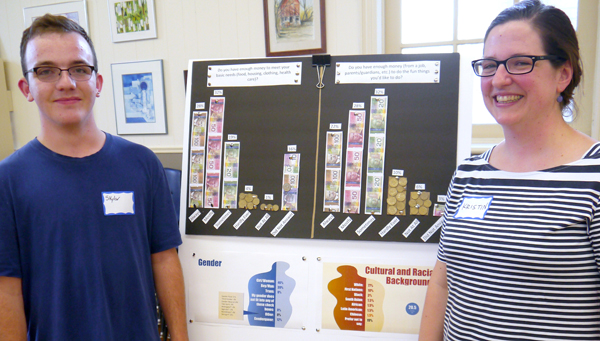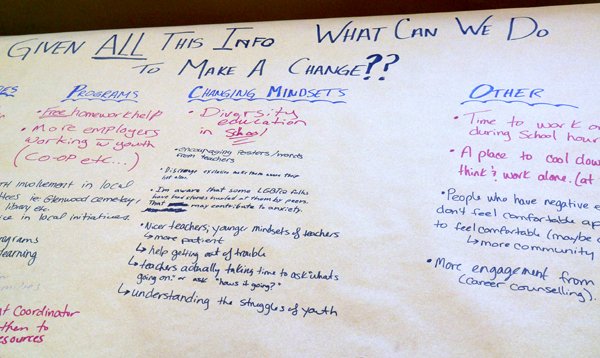Youth wellness report aim to enhance a positive community
Administrator | Sep 18, 2018 | Comments 1

Skylar Gray and Kristin Wheatcroft were presenters at the Greater Than: County Youth Collective drop-in information session.
Story and photos by Sharon Harrison
A snapshot of Prince Edward County’s youth identifying struggles they face and what they need to succeed has been presented as part of an on-going community research project.
Over the past year, the ‘Greater Than: County Youth Collective’ interviewed more than 70 Prince Edward County youth aged 12 to 29 to create a ‘Youth Wellness Report’. The collective was formed out of a project by the Community Foundation from its 2013 Vital Signs report that identified education as an issue in the community.
The collective includes Prince Edward County youth, educators, youth-serving agencies and community organizations.
Results of the report were presented at a drop-in feedback session for youth held in Picton last week. Representatives from a youth team of community partners explained findings and in an informal, relaxed space, ideas, thoughts, worries and opinions were encouraged, shared and brain-stormed through talking, writing and drawings.
“This is a feedback session for youth so that they can take a look at the data and ask questions,” said Kristin Wheatcroft, of the County Youth Collective.
“Over the past few years, educators, youth and community leaders have been working together with the goal of raising the high school graduation rates in the County to parity to the rest of Ontario,” said Wheatcroft. “Our project isn’t necessarily about in school, but it’s about the supports around school, with family, mental health and wellness, youth feeling empowered and that their voices matter in the community. And our feeling is that by addressing those issues, then youth will do better in school,” she said.
Four stations covered demographics, mental wellness, community and youth engagement.
The demographics portion showed the average age of participants to be 20.5 years old with 46 per cent female and 39 per cent male. Seventy-seven per cent identified as white, 10 per cent as First Nations and three per cent as black. One-and-a-half percent of participants each identified as south Asian, African, Latin American and Chinese, with 19 per cent preferring not to answer.
“When we asked people why they preferred not to answer the cultural and racial background question, we heard things like people weren’t sure of their racial background, were adopted or only knew one parent,” said Wheatcroft.
In the sexual orientation segment, 65 per cent identified as heterosexual, with bisexual at 12 per cent, and homosexual at 10 per cent. Two per cent identified as ‘questioning’, one per cent identified as asexual, one per cent as pansexual, and two per cent did not answer. It was noted no participants identified as either lesbian or queer.
“There is a real shift now in how comfortable youth are in identifying their gender and sexuality, and they are much more comfortable,” said Wheatcroft.
Participants were asked if they had enough money to meet basic needs of food, housing, clothing and healthcare. Twenty-eight per cent said ‘always’, 32 per cent answered ‘mostly’, 19 per cent said ‘sometimes’, four per cent answered ‘hardly ever’, one-and-half percent said ‘not at all’ and 16 percent did not answer.
“It is significant that only 28 per cent answered ‘always’, said Wheatcroft. “Interestingly, basically everyone else at some point is having some issue with basic needs.”
She stated that a closer look at why 16 per cent of respondents chose to not answer the question of having enough money for basic needs, showed fear around child protection came up multiple times. She said that the concrete fear was someone would see the survey and somehow it would be attached to a person’s name and if a family was having trouble with meeting basic needs, that could become a child protection issue.
A related question asked if participants had enough money (from a job, parent/guardian, etc.) to do the fun things they would like to do. Twenty-two per cent replied ‘always’, 28 per cent said ‘mostly’, 32 per cent answered ‘sometimes’, 10 per cent answered ‘hardly ever’, six per cent said ‘not at all’ and three per cent did not answer.
While the event was geared to County youth aged 12 to 29, adults interested in community youth issues were also welcomed.
Ashley Watson, of the Prince Edward Learning Centre, presented highlights from the mental wellness portion of the survey. She noted most participants felt optimistic about their life and their future, and as well, most felt they would leave a legacy. A much lower response came from knowledge surrounding resources and identifying individual symptoms.
“They do have symptoms, but I don’t know if they know they are related to mental health,” said Watson. “They don’t know their resources, they don’t know who to reach out to and they don’t know their symptoms either,” she said.
“We took all the answers and pulled out certain significant differences between populations. There was the LGBTQ+ youth who reported feeling dizzy, low (depressed), sad and suffered with more backaches.”
Indigenous youth reported having less fun with their friends but were feeling their parents treat them fairly more frequently and they reported feeling less sad.
“Out of everybody who did the surveys, they [Indigenous youth] reported feeling happier and had a better family life,” said Watson.
Girls and women reported having more experiences of nervousness, as well as stomach aches.
“I’ve had people tell me that writing it down, makes it real so they don’t want to check ‘yes’ they have mental health issues because they don’t want to face it, so it’s a difficult thing,” said Watson
Sydney, from the Recreation Outreach Centre, presented the community engagement module addressing civic participation – involvement; socio-political control, which speaks to how much of a voice and influence youth feel they have in the community; and a sense of community, which speaks to how they feel they belong.
Significant differences in populations were noted with Indigenous youth reporting higher levels of socio-political control, and LBGTQ+ youth reporting lower levels of socio-political control.
Christian, of the County Youth Collective, presented the youth engagement module of the survey with assistance from Skylar Gray, youth engagement worker with Community Living Prince Edward. Categories included safe environment, diversity, youth voice in decision making, youth staff partnerships and features of positive developmental settings.
Survey results showed youth felt less respected with bullying and aggression more tolerated, and youth feeling less welcome and less safe in the community in general.
“They are reporting that their ideas are taken less seriously, they aren’t expected to voice their concerns, they don’t have much say in the programs or decisions about what they do,” said Christian. They did, however, feel their involvement was more connected to their work, school and community.
Further, LGBTQ+ youth reported feeling less safe than their heterosexual peers and also feeling less connected.
Girls and woman report significantly higher scores across all categories. “This is great for women, but I am wondering what about boys and men? said Christian. “Why aren’t they feeling the same way?”
Gray joined the County Youth Collective two years ago because he found that youth have a tough time especially in the 12 to 29 age group and mostly during 16 to 18 years of age because they are still deciding what to do with their lives.
“I joined mainly to better their life and make it easier because those years are stressful enough. They should feel more connected and more rooted in the community to make their time a little easier,” said Gray. Because if they are not connected to the community, they feel less respected and more stressed out during those years trying make all those decisions.”
“We’ve seen a lot of youth come through today,” said Gray. “A lot of them took it more seriously than we thought, so that’s great. I love the feedback we got.”
Gray says toxic masculinity is a reason males don’t feel as respected or supported as females because they are supposed to be one way. “They are not supposed to care about these things or to show emotion,” said Gray. “Girls and females, which I think is great, have a lot of support here in the County, but the male people don’t have as much support.”
“Male youth don’t feel like their opinions matter as much [as female],” added Christian.
The research project aims to make positive change in the community as solutions to unique issues facing youth are explored.
“It’s a long-term project and we have given ourselves 10 years,” added Wheatcroft.
“We are looking to improve in all the areas of what we call our five pillars: family, caregivers and peers; well-being; empowerment; education support; and career and employment. It’s really a holistic approach and improving the lives of the kids here,” said Wheatcroft. “And in turn, our theory is graduation rates will rise.”
While survey participation was low, it is anticipated that surveys will continue on an annual basis now that a baseline has been established.

Filed Under: Arts & Culture • Featured Articles
About the Author:
































This is such an important study. Congratulations to those community organizations who are taking the time to understand our youth by working toward a holistic approach to address lack of support while encouraging empowerment.